This post has been originally commissioned for SketchBook Blog in 2016. After the site’s migration, the original is no longer available, but you can still access the content here. Enjoy!
In my recent tutorial I showed you how to draw our furry friends, domestic cats. But did you know that you can use this knowledge to also create their bigger cousins? Lions, tigers, leopards, jaguars, snow leopards, cougars, and cheetahs—I will show you how to draw them all! Of course, if you want to draw them 100% accurately, it’s best that you use photos or observe the animals in a zoo. But if you want to draw them from your imagination, or to use some features of big cats for your creature design, this is the place for you! I will show you that a leopard isn’t just a spotted lion—or a tiger a striped one. Even without the characteristic colors and patterns big cats differ a lot from each other. Once you learn these differences, you’ll be able to recreate any species—and even create a new one.
Disclaimer: I will be heavily referencing the previous tutorial How to Draw Cats, so please read it first.
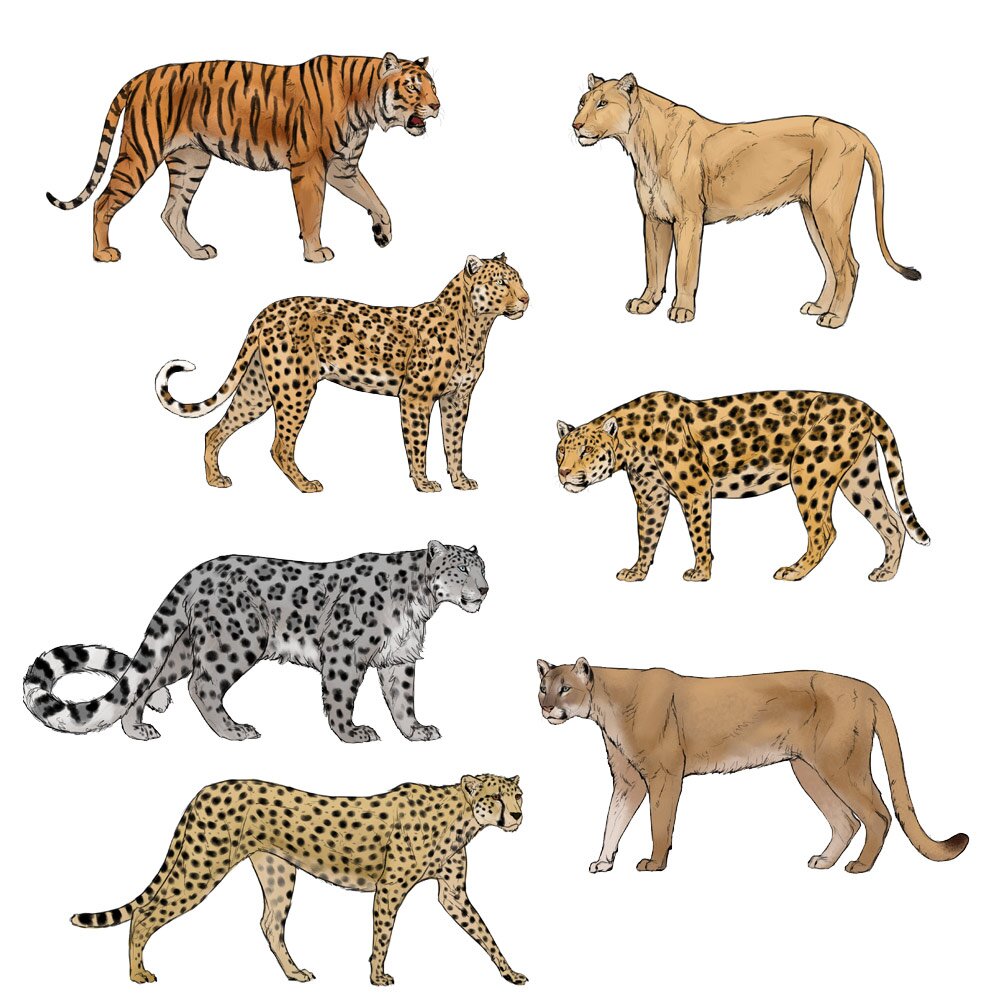
General Anatomy: Big Cat vs. Small Cat
Cats are cats, so you can use almost exactly the same simplified skeleton as a base for your big cat. On the left you can see a leopard with its face manipulated into the proportions of a small cat. Can you see anything wrong with its body? The elements that give the illusion away are be the elements you need to change.
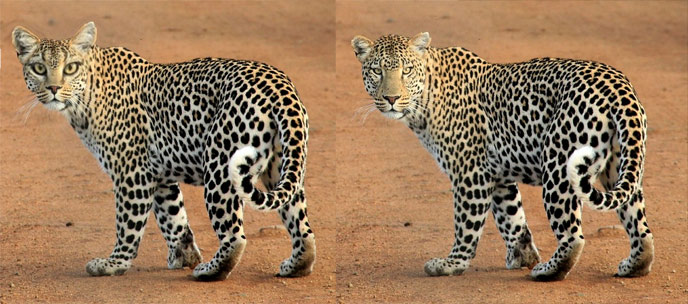
The answer? Big cats have bigger paws and a bigger torso.
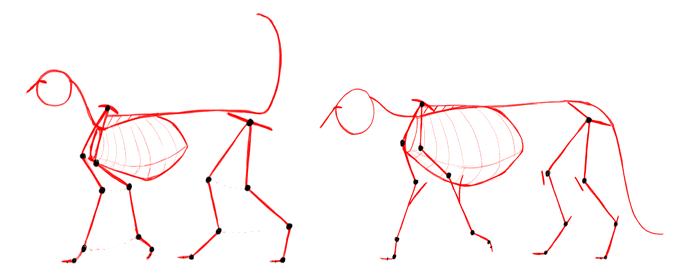
Big cats still have a very loose, pajama-like skin, but because they’re so big the muscle outline can be often clearly visible. A fur pattern can partially conceal it, but adding a subtle outline of the muscles still makes the cat look strong and powerful.
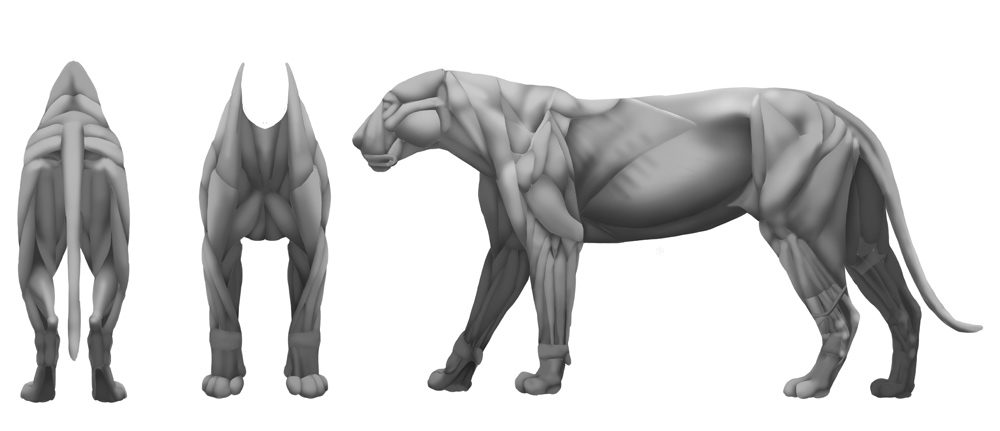
You don’t need to memorize all the muscles. Not all of them are the same visible, and we should care more about the structures they create. You can simplify the muscle structure to lines like these…
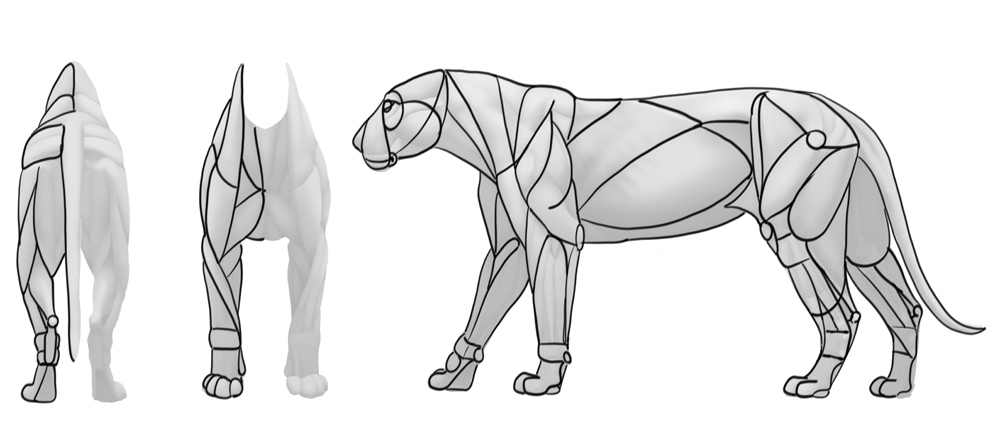
… and then turn these lines into outlines in the fur. Again, not all the lines are necessary. The structure of the feet is the most important, because they’re often skinny. Lack of muscle outline in the rest of the body can be justified with thick fur of the creature.
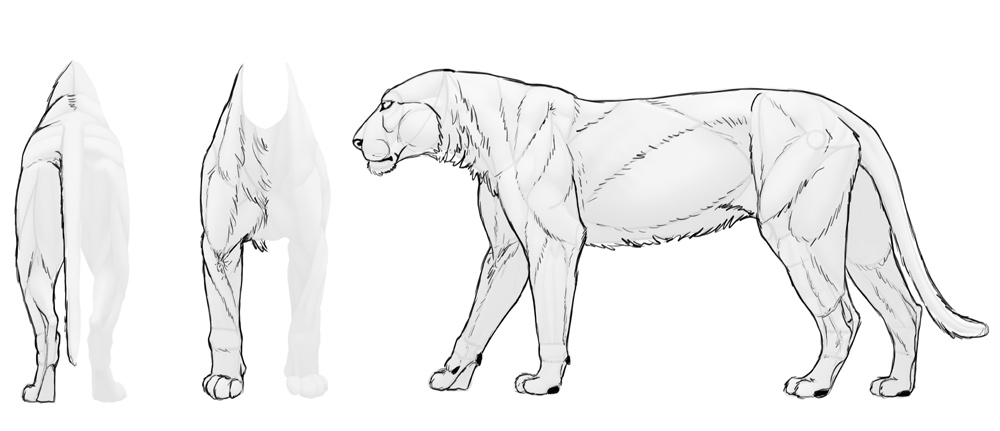
Let’s take a look at the facial proportions now. Big cats have the same skull shape as domestic ones, just bigger and more elongated. The bigger the species, the smaller and higher placed the eyes. The ears are much simpler to draw—you can imagine them as half-domes.
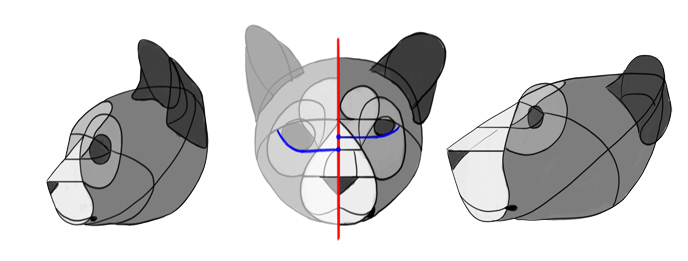
Aside from the construction, the details are also different. Big cats often have quite prominent beard and cheek-mane, both contributing to the final shape of the head. The eyelids have a clear dark edge, and the pupils are round (they get smaller in strong light instead of turning into a slit). The eyes are protected by eyelashes, and there’s an area of short hair right above them which makes the eyes look slightly bigger from distance.
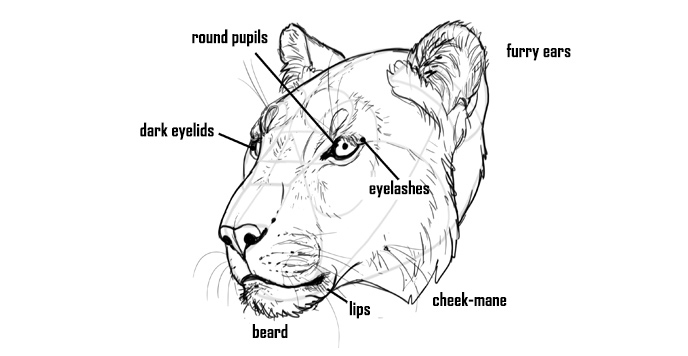
Big cats are also colored in a specific way:
- The lips often have a dark outline—when the mouth is closed, it creates a “drooping lip corner” effect.
- The muzzle has a bright front, usually white or a brighter version of the rest of the coat.
- The nose is usually brick red that gets spotted with brown/black dots as the animals gets older.
- The lines of whiskers can sometimes be darker at the ends, mostly in species with fur patterns.
- From behind the ears are dark towards the top, with a contrasting mark in the middle of the dark area. This occurs even in the plain colored species.
- The eyes have a bright area around which is supposed to reflect more light into them. This is true especially for nocturnal species.
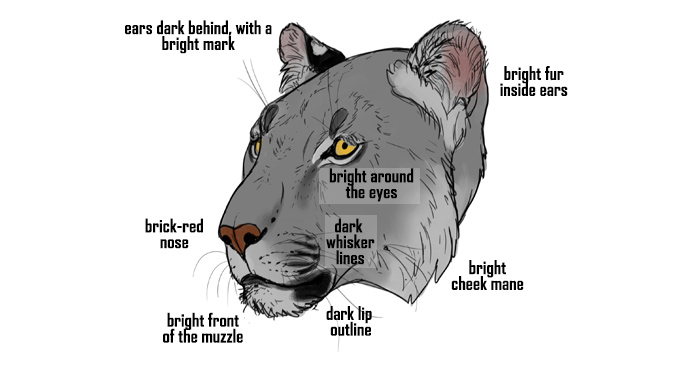
Mountain Lion (puma concolor)
Let’s start with the big cat that isn’t actually a big cat—it’s actually more closely related to domestic cats than to, say, a lion. That’s why it can be drawn easily if you can draw small cats. The muzzle is short, and the eyes are quite big for a big cat. And even the ears are quite pointed! Notice the characteristic elegant look of the eyes.
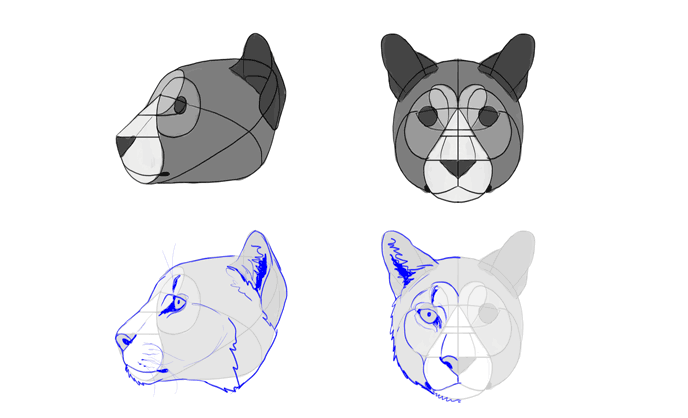
To draw a mountain lion draw a muscular cat with thick, coarse fur. Make the head small—it can even look unproportionally small. The hind legs may look slightly longer than the forelegs. The tail is long and fluffy, with a round tip.
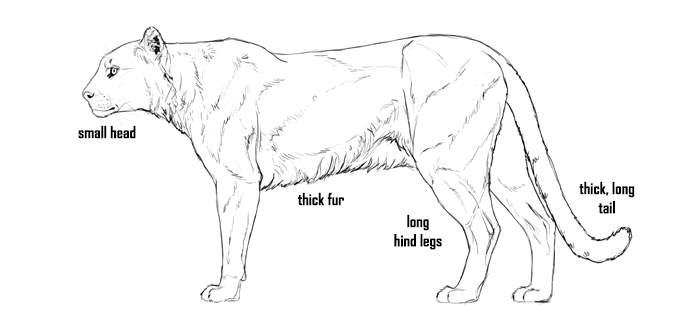
To color your mountain lion, start with light brown. It should be a cold shade of brown, more similar to violet than to orange. Then add a creamy white to its underside.

The tip of the tail can be black or dark brown. The face is grayish, with a black band coming from the nose to the lips. The lips don’t have any outline. The eyes can be dark yellow, green, or even pale blue.
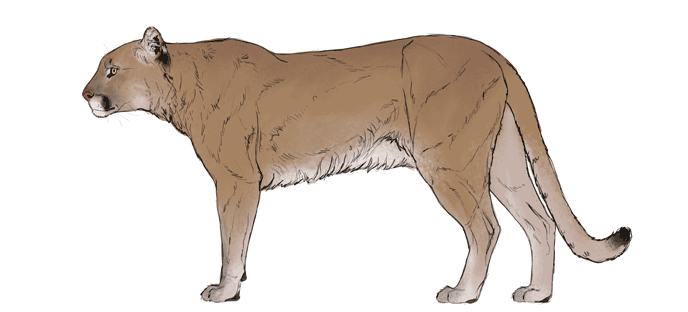
Let’s see how it looks in practice! You can exaggerate the features to make sure the viewers recognize the animal immediately.
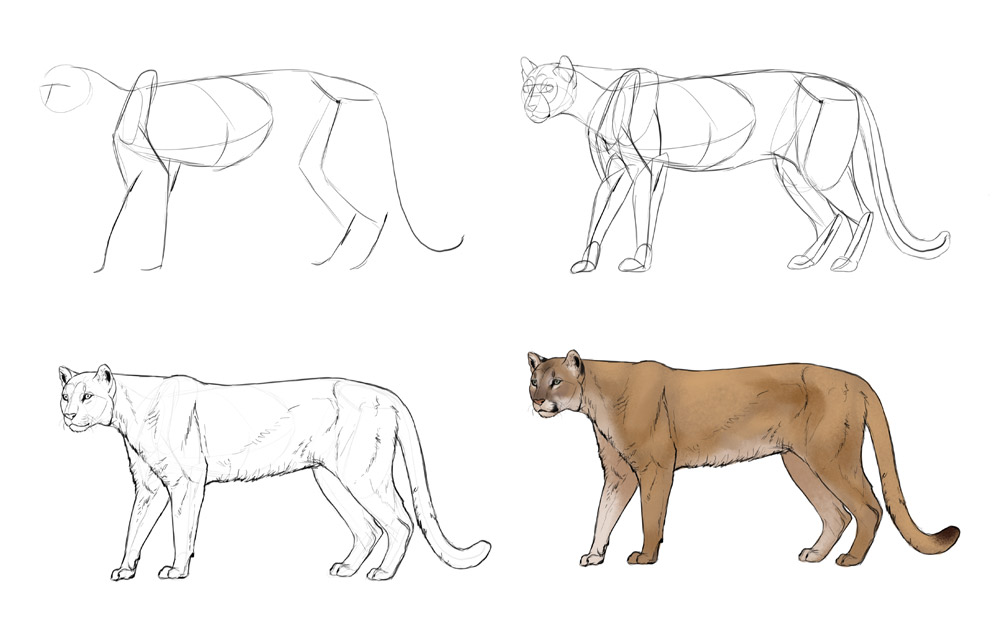
Leopard (panthera pardus)
Leopard is another cat with body very similar to a domestic cat, even though it’s a true big cat—a panther. The ears are round, but with a sharp look, and the eyes are rather big. The main difference lies in the large muzzle.
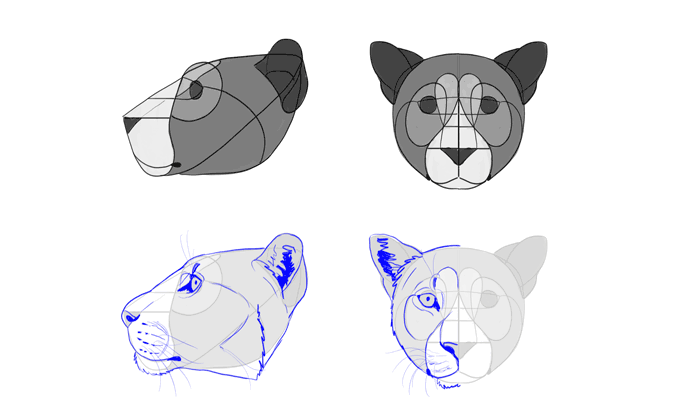
The body of a leopard is slender—that’s exactly how we often imagine panthers. Everything is very harmonious, from slim legs to the long tail (the longest of all panthers). Nothing should stand out too much—that’s the recipe for a leopard.
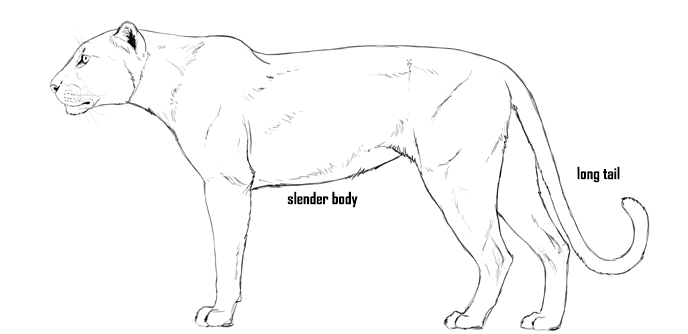
To color a leopard, start with a sand color, more yellowish than reddish. Then you can add warmer tones in the places where skin bends, and a bright underside. Take a darker shade for the spots, and draw them all over the body—the bigger the area, the bigger the spots. The should be placed quite tightly and regularly. Next, color the bottom spots with black.
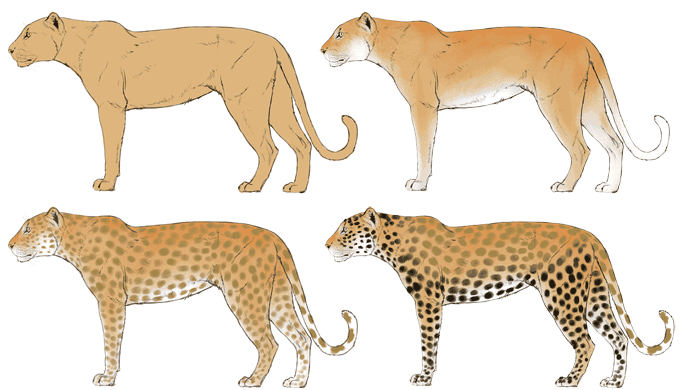
Each remaining spot should be surrounded with irregular black dots, creating rosettes. Finish the leopard by adding black outline around the lips and at the ends of the whisker lines. The eyes can be yellow or green. Remember that the spots lie on a 3D surface of the animal body, so they can’t look like a 2D pattern—wrap them around the imaginary forms for a more realistic look.
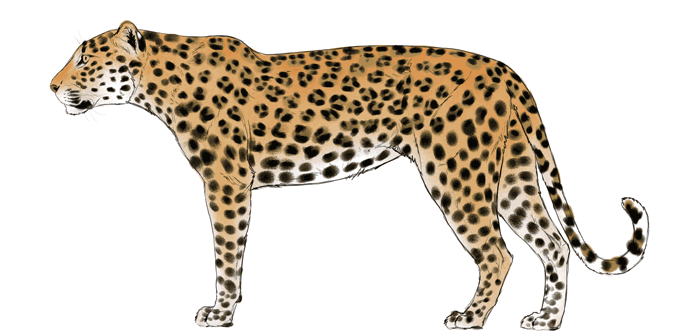
Let’s draw a leopard step by step:
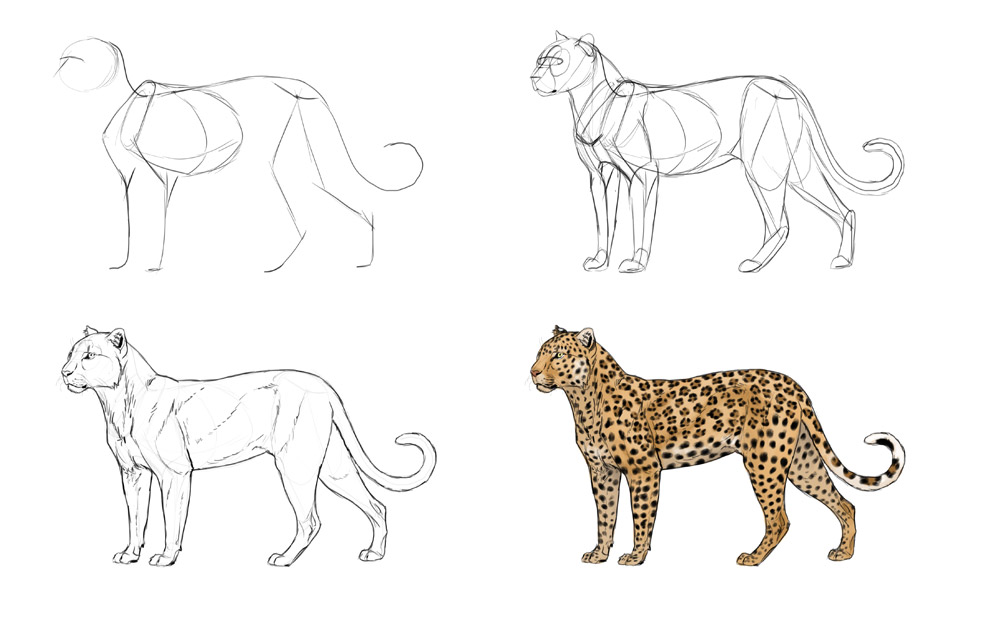
But that’s not all! This was the African leopard (Panthera pardus pardus), but there’s also a less known, very rare subspecies, the Amur leopard (Panthera pardus orientalis). You can think of it as a “winter” version of a leopard. It’s smaller than its African cousin, but it appears larger because of longer fur. In winter its coat can get very pale, making it similar to a snow leopard.
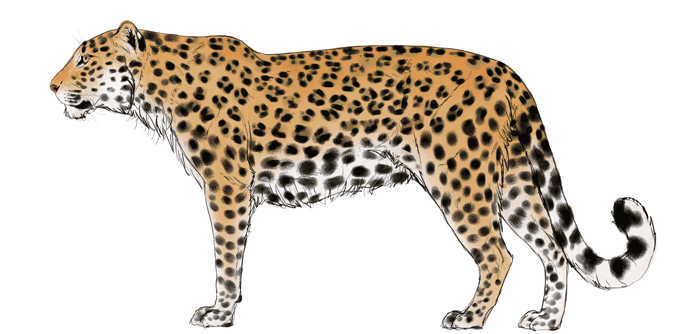
But we can’t forget about famous black panther! It’s nothing more than a melanistic version of a leopard—it’s not a subspecies, just a rare color variation. All leopards can be born black, even the Amur ones! The blackness is not complete—the coat is actually just darker, with the spots still visible in a strong light.
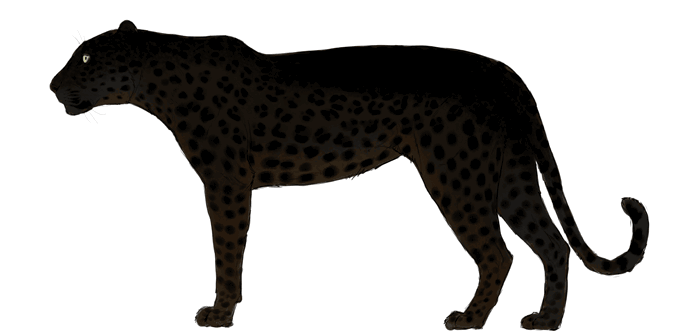
Jaguar (panthera onca)
Jaguars are often confused with leopards, but they’re actually pretty different. A face of a jaguar is very characteristic—it has very powerful jaws, designed to break both shells of turtles and animal skulls. Strong muscles are needed for such a bite, so jaguars seem to have very round cheeks. Because of these proportions the muzzle may look relatively short.
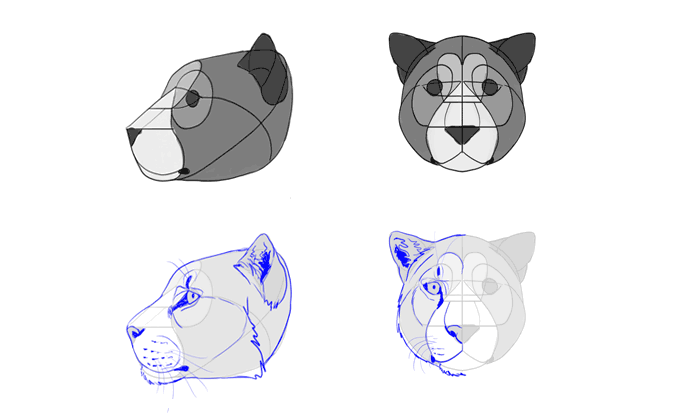
Jaguars are big—they can weight even twice as much as leopards. They’re heavily built, with broad forequarters and a short tail. The head may look quite big.
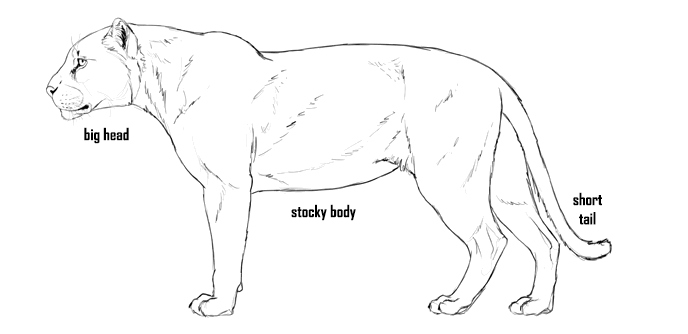
You can color a jaguar in a similar way to a leopard, except the spots should be larger. They also often have a more contrasting coat—darker yellow/orange with a pure white underside.
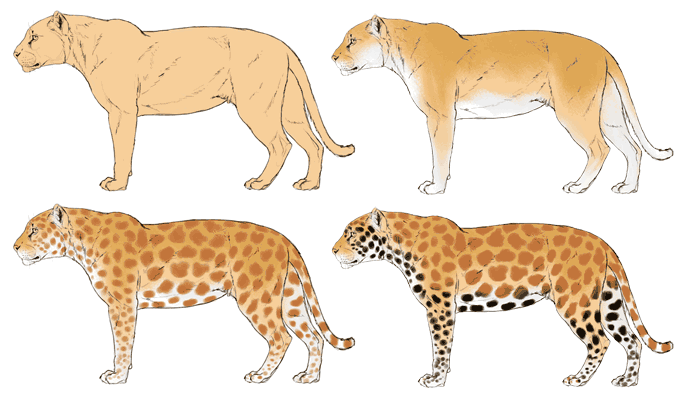
A very important detail: jaguar rosettes have small dots in the middle. The lip outline is very wide and dark, and the darkened whisker lines are very prominent. The “tear paths” behind the eyes is very long, ending with a darkened area beneath. The eyes can be yellow, green, pale blue, or even dark red.
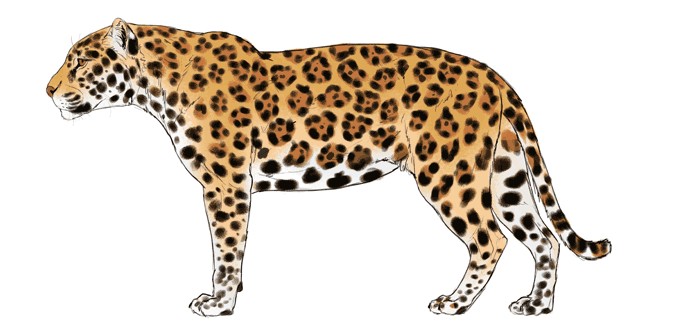
Let’s see how to draw a jaguar:
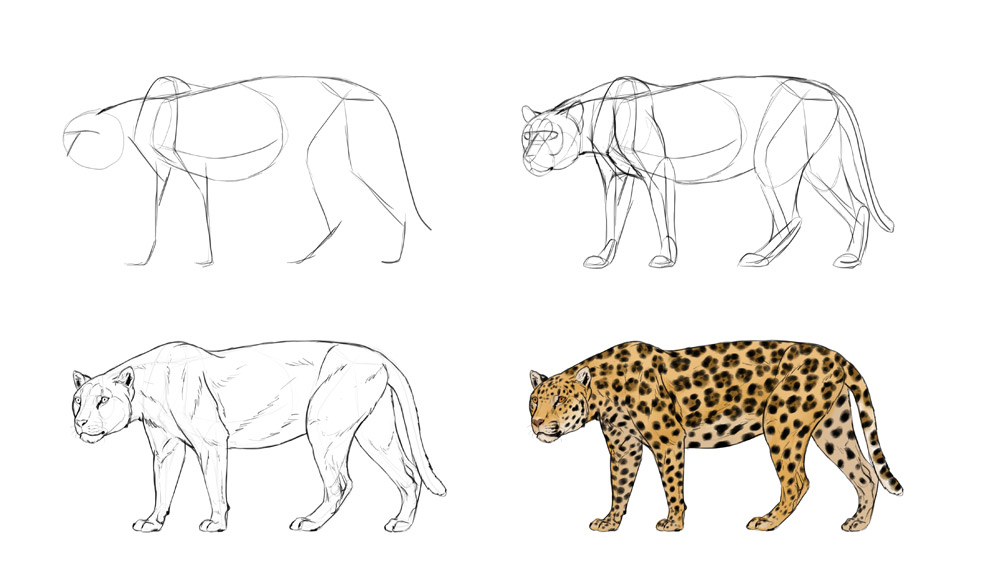
Jaguars have their melanistic form as well:
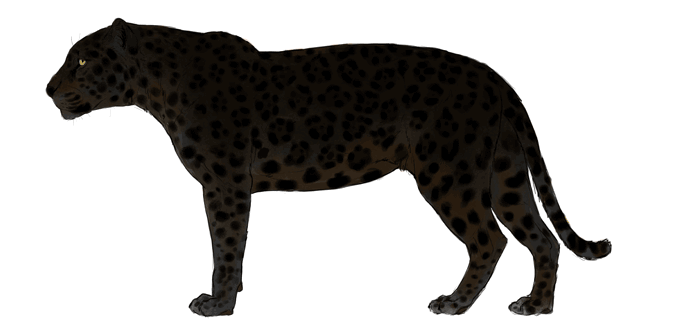
Lion (panthera leo)
Time for the most popular big cat! Lions are considered the largest cats, although this is controversial—they’re the tallest at shoulders, but tigers (especially the Amur ones) can weight much more. Being twice as big as a common jaguar their eye seem very small in their huge heads. They also have a characteristic long muzzle with as prominent beard, especially in males. The ears are 100% round (which, as you’ll learn soon, is typical for a cat of this size).
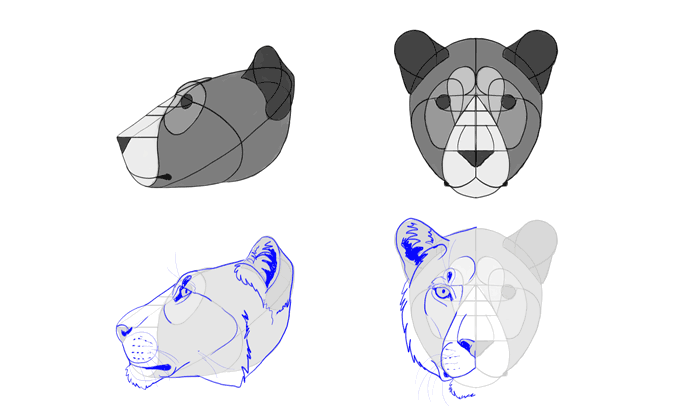
The head is the most important for a lion look, but there are two other things you need to pay attention to: large paws and a tufted tail. The fur on the body is quite short, hence the tail is not very thick, but it suddenly becomes so on the tip. To draw the tuft correctly you can imagine the tail of a leopard that has been shaved in a fancy way. The front of the chest (“breasts”) is fluffy.
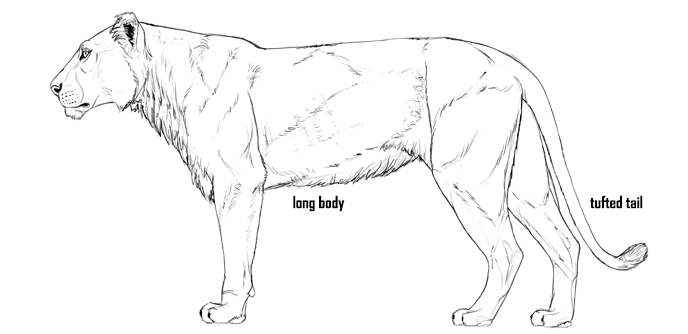
As for the colors, lions can have a range of shades for their fur: from pale yellow to tawny. Male lions’ coat is usually colder in hue (with a tint of desaturated red). The underside is brighter, although is rarely white. The lower part of the body is often covered with faded spots, more visible in younger specimens. The tail tuft is brown or black. The ear is brown behind in the upper half. The lip outline is often more brown than black and not very prominent in females. The eyes are usually yellow or brown.

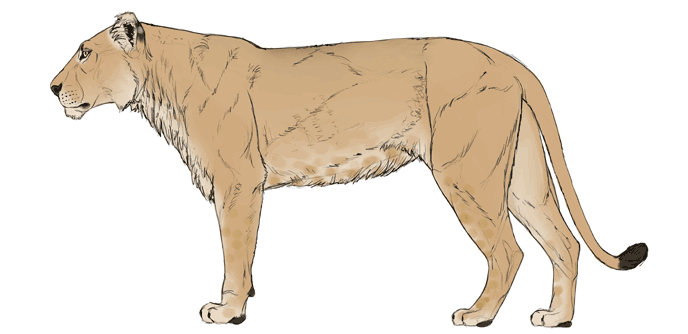
Males are bigger than females, they can also be more heavily built. Adult males have a mane that’s nothing more than longer fur on the cheeks, neck, and scruff (so these are the parts you need to make slightly longer for a juvenile lion to make it different from a juvenile lioness). Longer fur may also appear on the elbows and on the lower part of the belly. The mane is usually darker on the back—dark brown or even black.
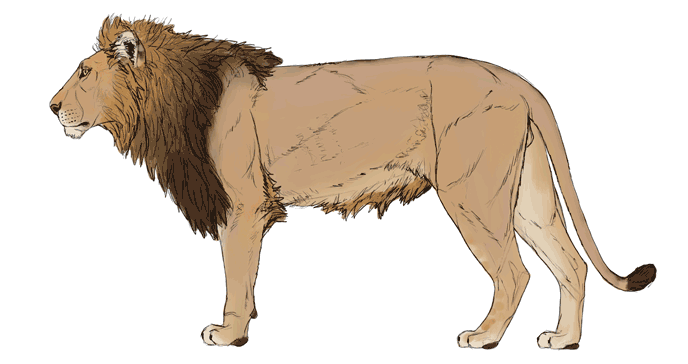
Let’s draw a lioness!
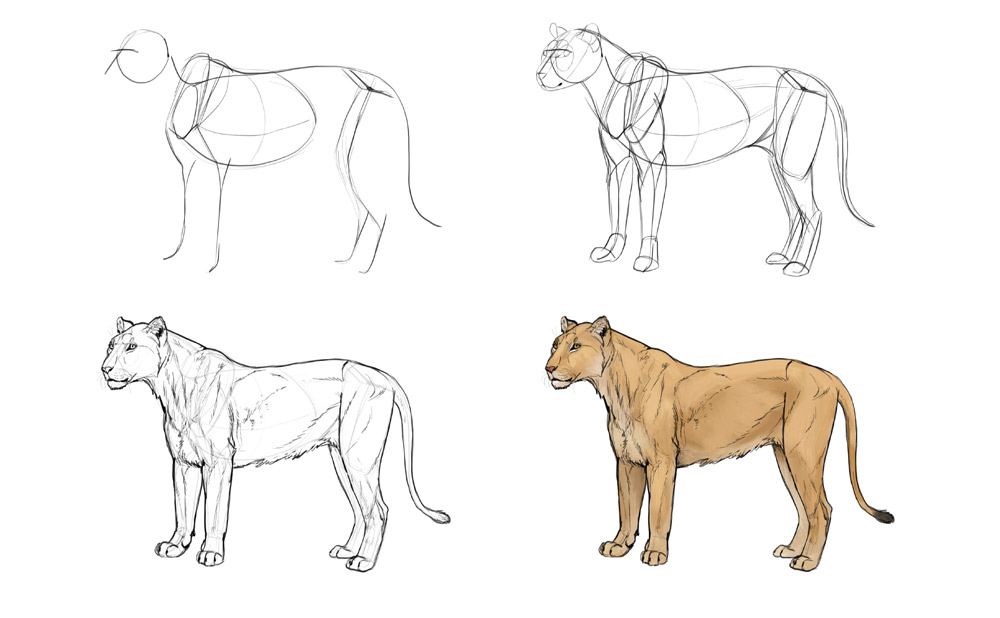
Tiger (panthera tigris)
If a lion can be seen as a large version of a leopard, tiger can be a big version of a jaguar. It has small eyes in a large, round face. The “tear paths” are quite long, and the cheek-mane and beard are very prominent.
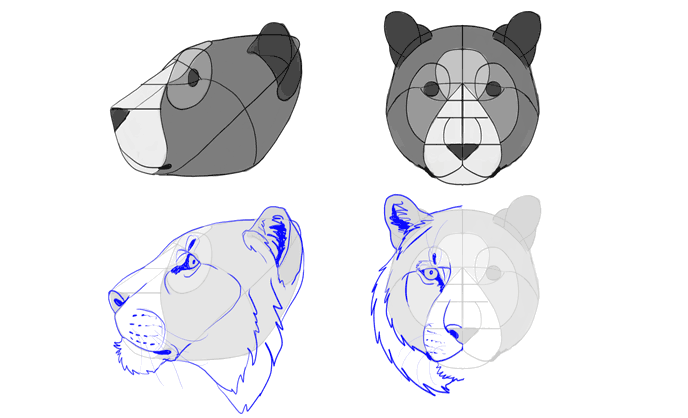
Tigers have a huge chest and large shoulders that make the forequarters look unproportionally big. The head look big as well, but the eyes must stay small. The paws are big, and tail is medium long, “tapering” (with a “sharp” tip).
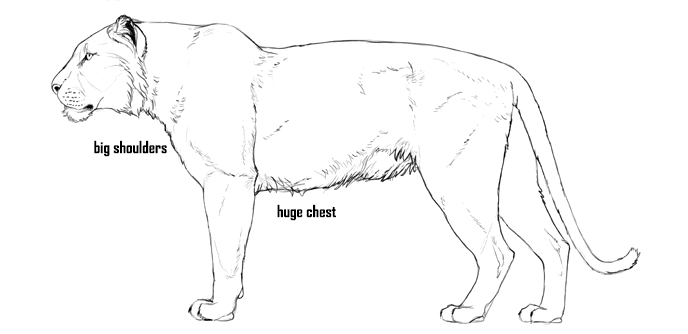
Tigers have a beautiful, orange coat with a creamy or pure white underside. The stripes pattern is unique for every specimen, but they usually look like in the image below: going from the top and from the bottom, all around the body, sometimes merging. The lip outline is dark and prominent, as well as the whisker lines. The eyes are usually yellow or amber.

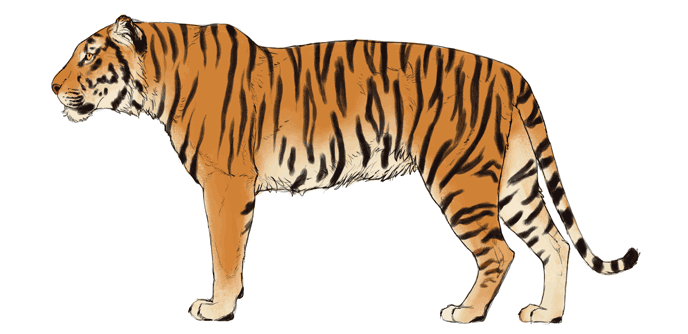
Let’s see how to draw a tiger in practice:
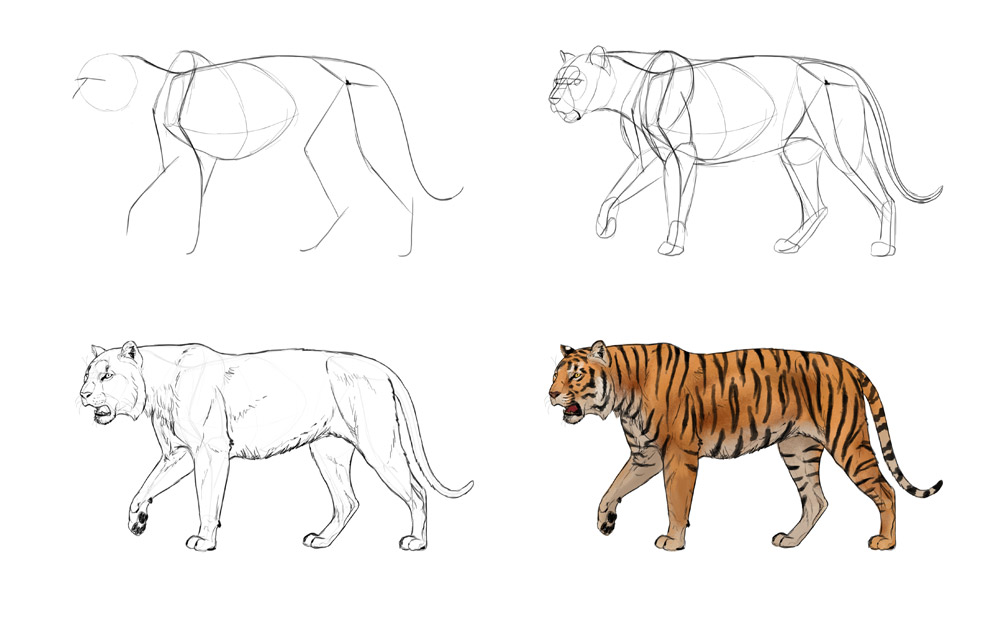
But that was the more popular subspecies—the Bengal tiger (panthera tigris tigris). There’s also the Amur tiger (panthera tigris altaica): a larger subspecies with a characteristic long fur.
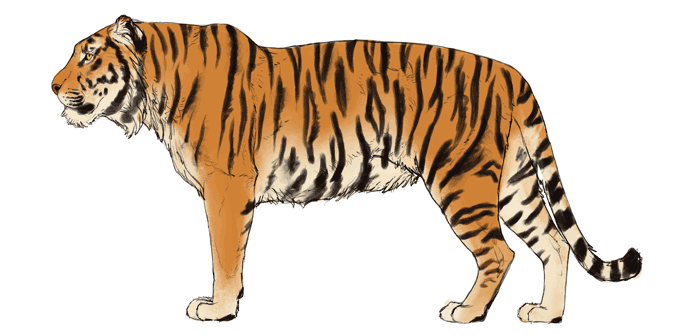
Just like some leopards or jaguars are born black, some Bengal tigers are born white. This is not a subspecies—it’s a mutation that is proven to be harmful in wild, breaking the natural camouflage of the animal. Still, they’re very pretty, and that’s why zoos like to breed them. White tigers are not completely white—they still have a lighter underside, although it’s very subtle. Their eyes are blue, and the nose is bright pink (they tend to get darker with age, as the nose is getting covered with the dark spots).
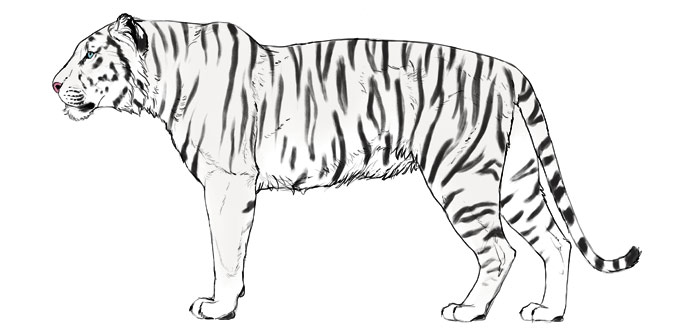
Snow Leopard (panthera uncia)
This rare cat has been recently considered a part of panthera family, even though it differs a lot the other panthers—for example, it cannot roar. Its head is quite similar to a jaguar, except the eyes are bigger, and the ears rounder. The eyes are deeply set in fur, which gives them a characteristic elegant look. The furry forehead is very prominent.
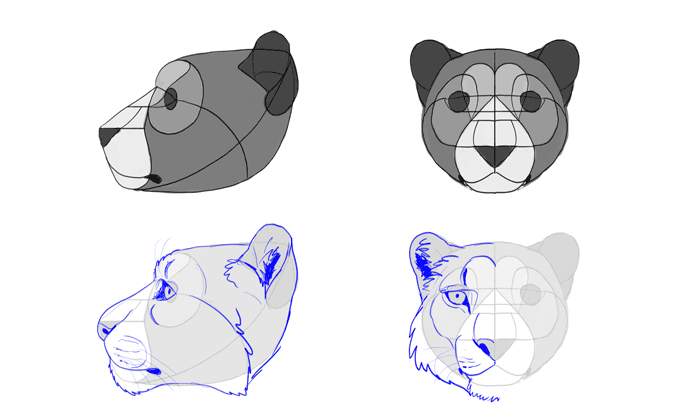
Snow leopards have a very characteristic body with a few unique features. The tail is very thick and long—the animal can curl it around its body for warmth. The body look stocky because of the large amount of fur. The paws are grotesquely big, acting like snowshoes. The head may look quite small in comparison to the body. The hind legs are longer than the front ones, but it’s not always visible.
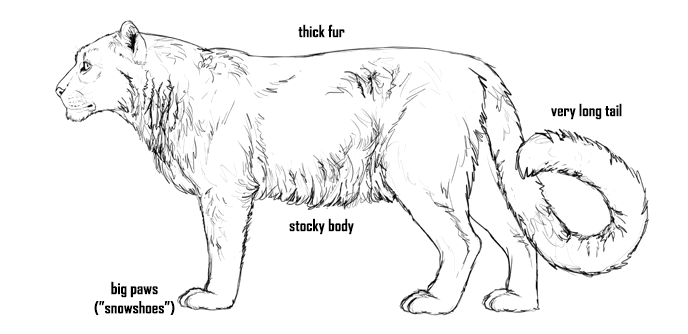
Snow leopard can be a bit tricky to color. First use a warm shade of gray (tinted with yellow). Then cover the upper part of the body with a cooler shade (tinted with blue), and the lower part with white. Paint the spots with dark gray first (the bigger the part of the body they’re on, the bigger the spots), then blacken the lower area.

Finally, surround the remaining spots with black spots, creating big rosettes—much bigger than in other cats. The lip outline is dark. The eyes can be yellow, green, or pale blue.
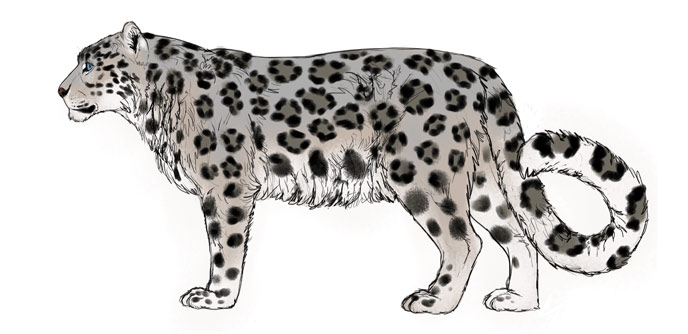
Let’s draw a snow leopard, shall we?
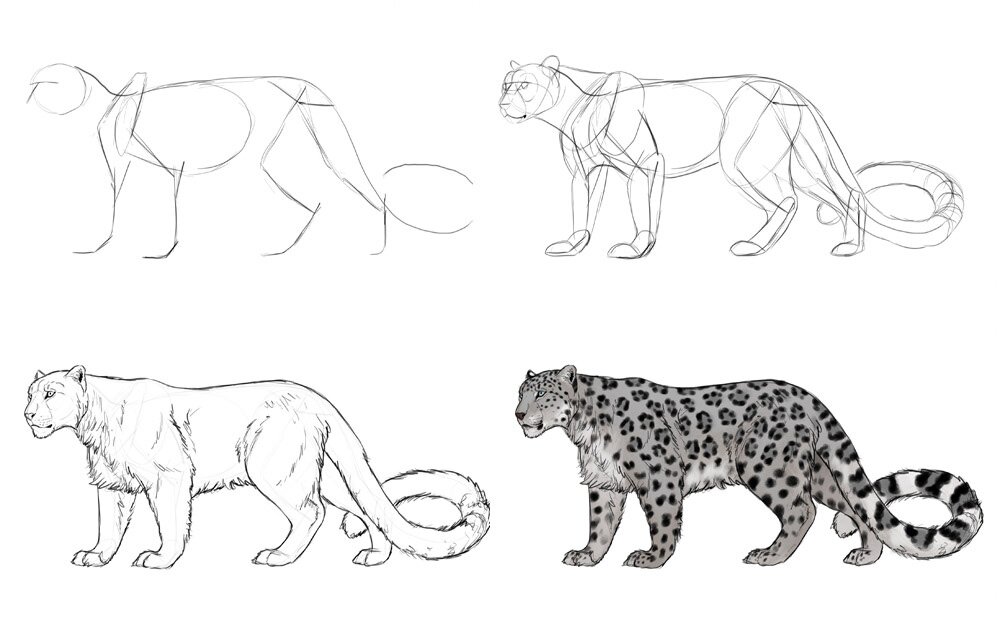
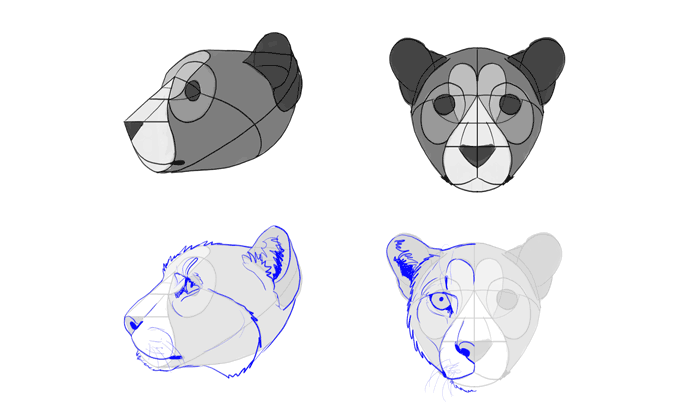
Cheetah (acinonyx jubatus)
Cheetahs aren’t closely related to any other cats—they’re a part of family of their own. In many aspects (including personality), they’re actually more similar to dogs than to cats! When it comes to the facial features, the head is small, round, with a short muzzle. The ears are round, and the eyes are very big. The forehead is fluffy, creating a characteristic ridge above the eyes.

Cheetah has a characteristic silhouette, streamlined for running. The legs are very long, with elongated feet and “hands.” The torso is large, but there’s a thin waist right behind it. The tail is very long and quite thick (it’s used for steering). The head looks very small in comparison to the body. Last, but not least: the claws are not completely sheathed!
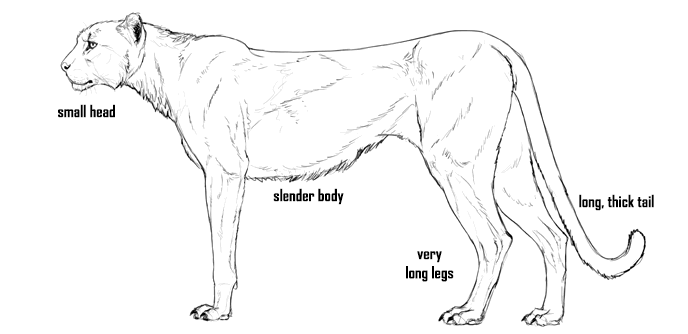
As for the colors, start with a sand yellow, then add a brighter underside.

The spots are black, small, and quite regular. There can be tiny dots between them. There’s a characteristic mark on the face—a black “tear path” going from the corner of the eye to the lips. Dark lip outline is present. The eyes can be dark amber or even red. Curiously, the nose is black.
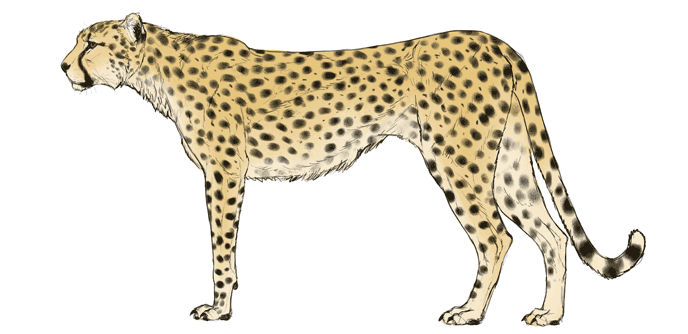
Cheetahs are so characteristic that it’s hard to draw them wrong:
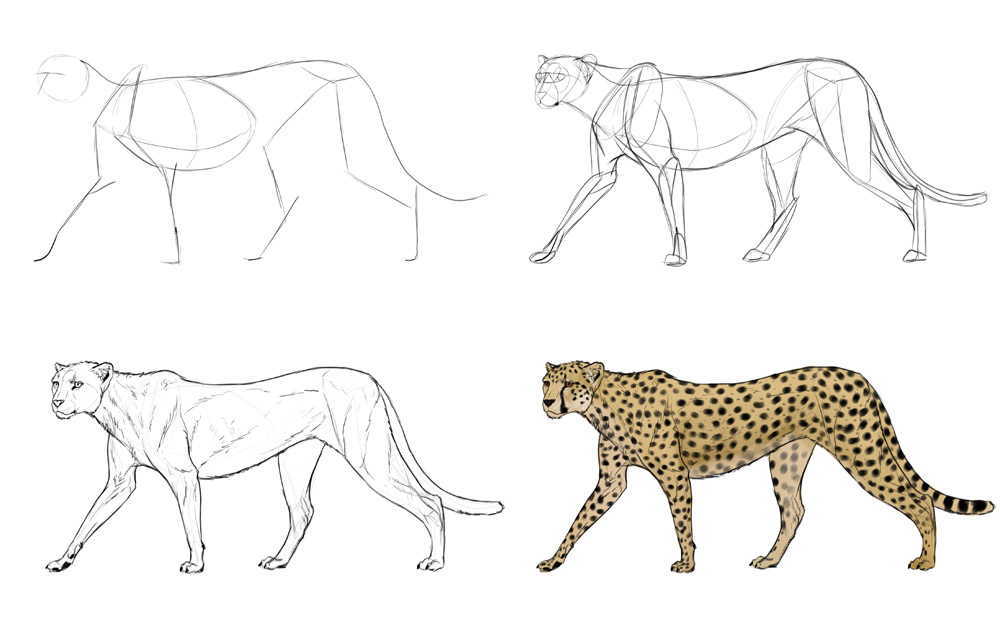
A rare genetic mutation can lead to a special pattern on the cheetah’s coat. The spots are merged together to create “blobs.” King cheetahs, because that’s how they’re called, are also often slightly fluffier, with a thicker tail, longer fur on the belly, and a dark mane on the scruff.
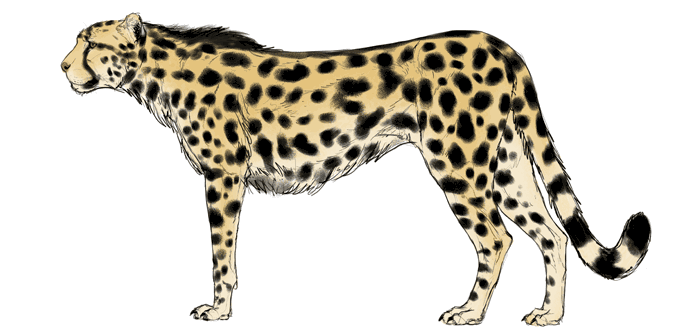
There’s also a very rare subspecies of cheetah—Asiatic cheetah (Acinonyx jubatus venaticus). It’s slightly smaller and slimmer than its cousin, but it can look larger because of longer fur in the same areas as the king cheetah.
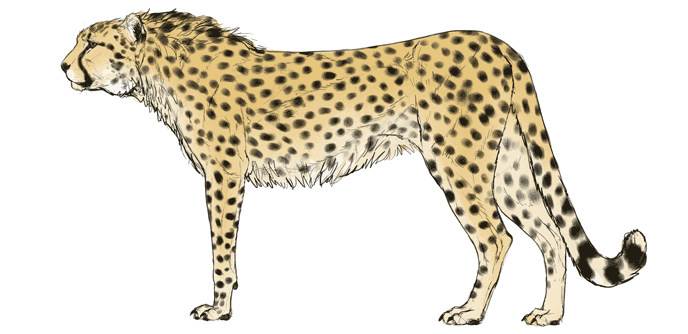
That’s All!
You have learned how to draw all the big cats, but not only this—now you are familiar with big cat anatomy and features, so you can bend the rules to create your own realistic species, like my “cave tiger” and the “jumping panther”.
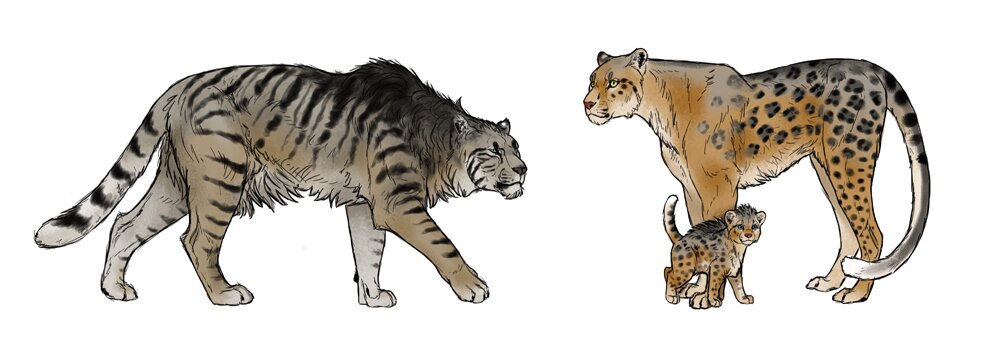
If you want to dive deeper into the topic of animal anatomy, consider joining my Patreon, where you’ll find a treasure trove of feline anatomy references designed for artists:

And if you’re looking for a “cheat sheet” for big cat anatomy, you should definitely check out my lion anatomy diagrams, available as a handy PDF—describing all the bones, muscles, and even soft tissues, in an artist-friendly form. They’re a result of over two years of studies, and they’re exactly the kind of a reference I dreamed of as a beginner animal artist!

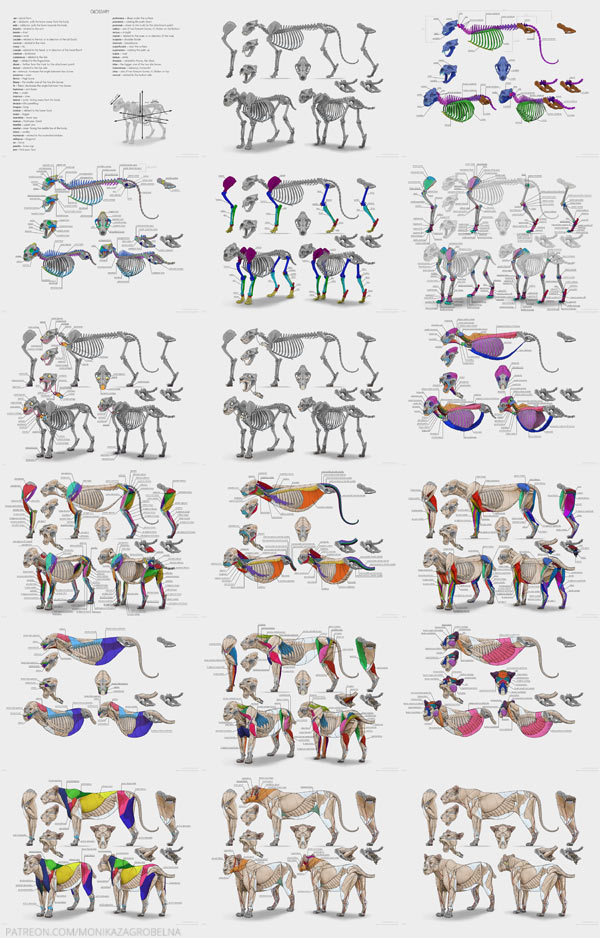
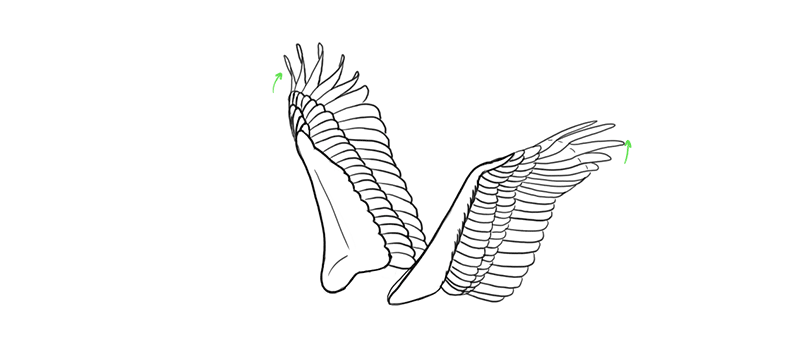
4 Comments